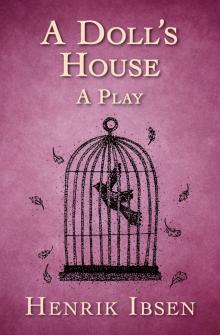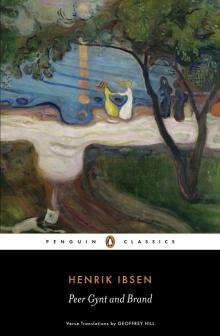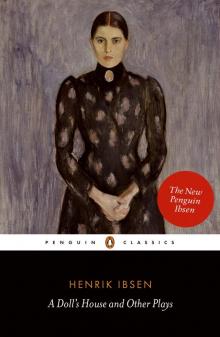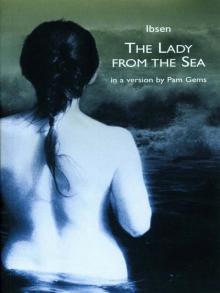- Home
- Henrik Ibsen
A Doll's House and Other Plays (Penguin)
A Doll's House and Other Plays (Penguin) Read online
Henrik Ibsen
* * *
A DOLL’S HOUSE AND OTHER PLAYS
with Pillars of the Community, Ghosts and An Enemy of the People
Translated by
DEBORAH DAWKIN and ERIK SKUGGEVIK
Introduced by
TORE REM
General Editor
TORE REM
Contents
Chronology
Introduction
Further Reading
A Note on the Translation
A Note on the Text
PILLARS OF THE COMMUNITY
A DOLL’S HOUSE
GHOSTS
AN ENEMY OF THE PEOPLE
Notes
Acknowledgements
Follow Penguin
PENGUIN CLASSICS
A DOLL’S HOUSE AND OTHER PLAYS
HENRIK IBSEN (1828–1906) is often called ‘the Father of Modern Drama’. He was born in the small Norwegian town of Skien and made his debut as a writer with the three-act play Catilina (1850). Between 1851 and 1864 he was artistic director and consultant for theatres in Bergen and Christiania (later spelt Kristiania; now Oslo), and contributed strongly to a renewal of Norwegian drama, writing plays such as The Vikings at Helgeland (1858), Love’s Comedy (1862) and The Pretenders (1863). In 1864 he left Norway on a state travel stipend and went to Rome with his wife Suzannah. This marked the beginning of what would become a 27-year-long voluntary exile in Italy and Germany. Ibsen experienced a critical and commercial success with the verse drama Brand (1866); this was followed by his other great drama in verse, Peer Gynt (1867), the prose play The League of Youth (1869) and his colossal Emperor and Galilean (1873), a ‘world-historical play’, also in prose. The next decisive turn in Ibsen’s career came with Pillars of the Community (1877), the beginning of the twelve-play cycle of modern prose plays. Here he turned his attention to contemporary bourgeois life, rejecting verse for good. This cycle would include A Doll’s House (1879), Ghosts (1881), An Enemy of the People (1882), The Wild Duck (1884), Rosmersholm (1886), The Lady from the Sea (1888), Hedda Gabler (1890), The Master Builder (1892), Little Eyolf (1894), John Gabriel Borkman (1896) and, finally, When We Dead Awaken (1899). By the time Ibsen returned to Norway in 1891, he had acquired Europe-wide fame, and his plays soon entered the canons of world literature and drama. Following a series of strokes, he died at home in Kristiania at the age of seventy-eight.
DEBORAH DAWKIN originally trained and worked as an actress and theatre director for ten years. She has worked as a translator from Norwegian to English for ten years in collaboration with Erik Skuggevik and independently, translating novels, short stories, cartoons, poetry and non-fiction. Her translation of Johan Harstad’s Buzz Aldrin, What Happened to You in All the Confusion? (2011) was longlisted for the Best Translated Book Award, 2012. With a particular interest in translation history, Deborah currently holds a Collaborative Doctoral Award with University College London and the British Library, researching the life and work of Ibsen translator Michael Meyer.
ERIK SKUGGEVIK has a background in theatre. He has worked as a translator from Norwegian to English for fifteen years. In collaboration with Deborah Dawkin, he has translated novels by Ketil Bjørnstad and Lars Ramslie and, over many years, the cartoon strip Nemi, as well as non-fiction works by Ingar Sletten Kolloen and Petter Aaslestad. He has been a lecturer in both Translation Studies and Intercultural Communication at the University of Surrey as well as a Norwegian teacher at University College London and the University of Oslo. He currently lectures in Interpreting Studies at Oslo University College.
TORE REM is Professor of British Literature at the Department of Literature, Area Studies and European Languages, the University of Oslo. He has published extensively on British and Scandinavian nineteenth-century literature and drama, including the books Dickens, Melodrama and the Parodic Imagination (2002) and Henry Gibson/Henrik Ibsen (2006), as well as on life writing, the history of the book, reception studies and world literature. Rem has been Christensen Visiting Fellow at St Catherine’s College, Oxford, was director of the board of the Centre for Ibsen Studies and is a member of the Norwegian Academy of Science and Letters.
Chronology
1828 Henrik Johan Ibsen born to Marichen and Knud Ibsen, a retailer and timber trader, in the town of Skien, 100 km south of Oslo (then Christiania).
1833 Starts school at Skien borgerskole (borgerskoler were schools for the bourgeoisie of the towns).
1835 Knud Ibsen is declared bankrupt. The family’s property is auctioned off, and they move to the farm Venstøp in the parish of Gjerpen, just east of Skien.
1843 Travels to the coastal town of Grimstad, about 110 km south of Skien, where he is made apprentice in an apothecary’s shop.
1846 Hans Jacob Hendrichsen is born to Else Sophie Jensdatter, the apothecary’s maid, on 9 October. Ibsen accepts patrimony and is required to pay maintenance for the next fourteen years.
1849 Writes Catilina, his first play, as well as poetry, during the winter. Has his first poem, ‘I høsten’ (‘In Autumn’), published in a newspaper at the end of September.
1850 Leaves Grimstad on 12 April, the publication date of Catilina. The play is published under the pseudonym Brynjulf Bjarme. Visits his family in Skien for the last time.
Goes to the capital, Christiania, where he sits the national high school exam in the autumn, but fails in arithmetic and Greek.
His first play to be performed, Kjempehøien (The Burial Mound), is staged at the Christiania Theater on 26 September.
1851 Starts the journal Manden, later Andhrimner, with friends.
The famous violinist Ole Bull hires Ibsen for Det norske Theater (the Norwegian Theatre), his new venture in Bergen. Ibsen begins as an apprentice, then becomes director and resident playwright. He agrees to write and produce one new play for the theatre every year.
1852 Spends over three months in Copenhagen and Dresden studying Danish and German theatre.
1853 Sancthansnatten (St John’s Night) opens on 2 January, the founding date of Det norske Theater.
1855 Fru Inger til Østeraad (Lady Inger of Ostrat) performed at Det norske Theater on 2 January.
1856 First real success with Gildet paa Solhoug (The Feast at Solhoug) at Det norske Theater; the play is subsequently performed at the Christiania Theater and published as a book.
Becomes engaged to Suzannah Daae Thoresen.
1857 Olaf Liljekrans premieres at Det norske Theater to a disappointing reception.
Moves to Christiania during the summer and takes up the position of artistic director at the Kristiania Norske Theater (Kristiania Norwegian Theatre) from early September.
First performance outside of Norway when The Feast at Solhoug is staged at the Kungliga Dramatiska Theatern (Royal Dramatic Theatre) in Stockholm in November.
1858 Marries Suzannah Thoresen in Bergen on 18 June.
Hærmendene paa Helgeland (The Vikings at Helgeland) has its first night at the Kristiania Norske Theater on 24 November and is met with a resoundingly positive response.
1859 A son, Sigurd Ibsen, is born to Suzannah and Henrik Ibsen on 23 December.
Writes the long poem ‘Paa Vidderne’ (‘On the Moors’) as a ‘New Year’s Gift’ to the readers of the journal Illustreret Nyhedsblad.
1860–61 Ibsen accumulates private debt, owes taxes and is taken to court by creditors. He drinks heavily during this period, and the family has to move a number of times. He is criticized for his choice of repertory at the Kristiania Norske Theater.
His epic poem ‘Terje Vigen’ appears in Illustreret Nyhedsblad.
1862 The theatre goes bankrupt, and Ibsen is with
out regular employment.
Ethnographic expedition to the West of Norway in summer, collecting fairy tales and stories.
Publishes Kjærlighedens Komedie (Love’s Comedy) in Illustreret Nyhedsblad.
1863 Employed as ‘artistic consultant’ at the Christiania Theater from 1 January and made able to pay off most of his debts. The first, short Ibsen biography published by his friend Paul Botten-Hansen in Illustreret Nyhedsblad. Applies for a state stipend in March, but is instead awarded a travel grant of 400 spesidaler (in 1870 a male teacher would earn around 250 spesidaler a year) for a journey abroad.
Kongs-Emnerne (The Pretenders) published in 1,250 copies in October.
1864 The Pretenders performed at the Christiania Theater on 17 January. A great success.
Ibsen leaves Norway on 1 April and settles in Rome.
1865 Writes Brand in Ariccia.
1866 The verse drama Brand is published in 1,250 copies by Ibsen’s new publisher Gyldendal in Copenhagen on 15 March, with three more print runs before the end of the year. The play is Ibsen’s real breakthrough, helping to secure financial stability.
Given an annual stipend of 400 spesidaler by the Norwegian government, plus a new travel grant.
1867 Writes the verse drama Peer Gynt on Ischia and in Sorrento. Published in 1,250 copies on 14 November, with a second, larger print run appearing just two weeks later.
1868 At the beginning of October moves to Dresden in Germany, where he lives for the next seven years.
1869 Travels to Stockholm for a Nordic meeting for establishing a common Scandinavian orthography. Publishes De unges Forbund (The League of Youth) in 2,000 copies on 30 September; the play is performed at the Christiania Theater on 18 October.
Travels from Marseilles to Egypt in October and participates as official guest in the festivities at the opening of the Suez Canal.
1871 Digte (Poems), his first and only collection of poetry, is published in 4,000 copies on 3 May.
The Danish critic Georg Brandes, the propagator of the so-called ‘Modern Breakthrough’, comes to Dresden and meets Ibsen for the first time.
1872 Edmund Gosse’s article ‘Ibsen’s New Poems’ appears in The Spectator in March.
1873 Gosse’s ‘Henrik Ibsen, the Norwegian Satirist’ appears in The Fortnightly Review in January.
Travels to Vienna in June, as a member of the jury for fine art at the World Exhibition.
Kejser og Galilæer (Emperor and Galilean) published in 4,000 copies on 16 October; there is a new print run of 2,000 copies in December.
Love’s Comedy performed at the Christiania Theater on 24 November.
1874 Ibsen and his family in Christiania from July to the end of September, his first visit since leaving Norway in 1864.
1875 Catilina published in revised edition to celebrate Ibsen’s twenty-fifth anniversary as a writer.
The family moves from Dresden to Munich on 13 April.
1876 Peer Gynt receives its first performance at the Christiania Theater, with music composed by Edvard Grieg.
Emperor and Galilean translated by Catherine Ray, Ibsen’s first translation into English.
The Vikings at Helgeland premieres at Munich’s Hoftheater (Court Theatre) on 10 April, making it the first Ibsen production outside of Scandinavia.
1877 Is made honorary doctor at the University of Uppsala in Sweden in September.
Samfundets støtter (Pillars of the Community) is published in 7,000 copies on 11 October and performed at the Danish Odense Teater on 14 November.
1878 Moves to Rome in September.
1879 Travels to Amalfi with his family in July and writes most of his new play, Et Dukkehjem (A Doll’s House), there. Goes on to Sorrento and then Rome in September and moves back to Munich in October.
Edmund Gosse publishes Studies in the Literature of Northern Europe, devoting much space to Ibsen.
A Doll’s House is published in 8,000 copies on 4 December and receives its premiere at Det Kongelige Theater (the Royal Theatre) in Copenhagen on 21 December.
1880 Ibsen returns to Rome in November.
Quicksands, an adaptation by William Archer of Pillars of the Community, at London’s Gaiety Theatre, 15 December.
1881 Goes to Sorrento in June and writes most of Gengangere (Ghosts) there; the play is published in 10,000 copies on 13 December and is met with much harsh criticism, affecting subsequent book sales.
1882 First performance of Ghosts takes place in Chicago on 20 May.
Miss Frances Lord translates A Doll’s House as Nora.
En folkefiende (An Enemy of the People) published in 10,000 copies on 28 November.
1883 An Enemy of the People first staged at the Christiania Theater on 13 January.
1884 Breaking a Butterfly, Henry Arthur Jones and Henry Herman’s adaptation of A Doll’s House, premieres at the Prince’s Theatre, London, on 3 March.
Vildanden (The Wild Duck) is published in 8,000 copies on 11 November.
1885 First performance of The Wild Duck at Den Nationale Scene (the National Stage) in Bergen on 9 January.
First performance of Brand at the Nya Teatern (New Theatre) in Stockholm on 24 March.
Henrik and Suzannah Ibsen go to Norway in early June. They travel back via Copenhagen at the end of September, and in October settle in Munich again, where they live for the six following years.
Ghosts, translated by Miss Frances Lord, serialized in Britain in the socialist journal To-Day.
1886 Rosmersholm published in 8,000 copies on 23 November.
1887 A breakthrough in Germany with the production of Ghosts at the Residenz-Theater (Residency Theatre) in Berlin on 9 January.
Rosmersholm staged at Den Nationale Scene in Bergen on 17 January.
1888 Ibsen turns sixty. Celebrations in Scandinavia and Germany. Henrik Jæger publishes the first biography in book form.
Fruen fra havet (The Lady from the Sea) published in 10,000 copies on 28 November.
Newcastle-based Walter Scott publishes Pillars of Society, and Other Plays (it includes Ghosts and An Enemy of the People) under the editorship of the theatre critic William Archer and with an introduction by Havelock Ellis.
1889 The Lady from the Sea premieres both at the Hoftheater in Weimar and at the Christiania Theater on 12 February.
The production of A Doll’s House, with Janet Achurch as Nora, at the Novelty Theatre in London on 7 June, marks his breakthrough in Britain. This production goes on a world tour.
Pillars of the Community is produced at London’s Opera Comique.
1890 André Antoine produces Ghosts at the Théâtre Libre (Free Theatre) in Paris, leading to a breakthrough in France.
The Lady from the Sea translated into English by Karl Marx’s youngest daughter, Eleanor.
Hedda Gabler published in 10,000 copies in Copenhagen on 16 December, with translations appearing in near-synchronized editions in Berlin, London and Paris.
1891 Hedda Gabler receives its first performance at the Residenz-Theater (Residency Theatre) in Munich on 31 January with Ibsen present. Competing English translations by William Archer and Edmund Gosse soon follow.
Several London productions of Ibsen plays, starting with Rosmersholm at the Vaudeville Theatre in February. In order to avoid censorship, Ghosts is given a private performance by the new Independent Theatre on 13 March, leading to a big public outcry. Hedda Gabler is produced under the joint management of Elizabeth Robins and Marion Lea in April, with Robins in the title role, and The Lady from the Sea follows in May.
George Bernard Shaw publishes his The Quintessence of Ibsenism, based on his lectures to the Fabian Society in the preceding year.
Henry James publishes ‘On the Occasion of Hedda Gabler’ in The New Review in June.
Ibsen returns to Kristiania (as it was now written after the Norwegian spelling review of 1877) on 16 July and settles there for the remainder of his life. This year he befriends the pianist Hildur Andersen, thirty-six years his junior, often co
nsidered the model for Hilde Wangel in The Master Builder.
1892 The Vikings at Helgeland is performed in Moscow on 14 January.
William and Charles Archer translate Peer Gynt in a prose version.
Sigurd marries the daughter of Ibsen’s colleague and rival Bjørnstjerne Bjørnson.
Bygmester Solness (The Master Builder) is published in 10,000 copies on 12 December.
1893 The Master Builder is first performed at the Lessingtheater in Berlin on 19 January. It is co-translated by William Archer and Edmund Gosse into English, and premieres at London’s Trafalgar Square Theatre on 20 February.
The Opera Comique in London puts on The Master Builder, Hedda Gabler, Rosmersholm and one act from Brand between 29 May and 10 June.
An Enemy of the People is produced by Herbert Beerbohm Tree at the Haymarket Theatre on 14 June. Ibsen’s first commercial success on the British stage.
F. Anstey (pseudonym for Thomas Anstey Guthrie) writes a series of Ibsen parodies called Mr Punch’s Pocket Ibsen.
1894 The Wild Duck at the Royalty Theatre, London, from 4 May.
Lille Eyolf (Little Eyolf) is published in 10,000 copies on 11 December.
Two English verse translations of Brand, by C. H. Herford and F. E. Garrett.
1895 Little Eyolf is performed at the Deutsches Theater (German Theatre) in Berlin on 12 January.
1896 Little Eyolf at the Avenue Theatre in London from 23 November, in a translation by William Archer.
John Gabriel Borkman is published in 12,000 copies on 15 December.
1897 World premiere of John Gabriel Borkman at the Svenska Teatern (Swedish Theatre) and the Suomalainen Teaatteri (Finnish Theatre) on 10 January, both in Helsinki.
1898 Gyldendal in Copenhagen publishes a People’s Edition of Ibsen’s collected works.
Ibsen’s seventieth birthday is celebrated in Kristiania, Copenhagen and Stockholm, and he receives greetings from all over Europe and North America.
1899 Når vi døde vågner (When We Dead Awaken), his last play, is published in 12,000 copies on 22 December.

 A Doll's House
A Doll's House Peer Gynt and Brand
Peer Gynt and Brand The Master Builder and Other Plays
The Master Builder and Other Plays A Doll's House and Other Plays (Penguin)
A Doll's House and Other Plays (Penguin) The Lady from the Sea
The Lady from the Sea